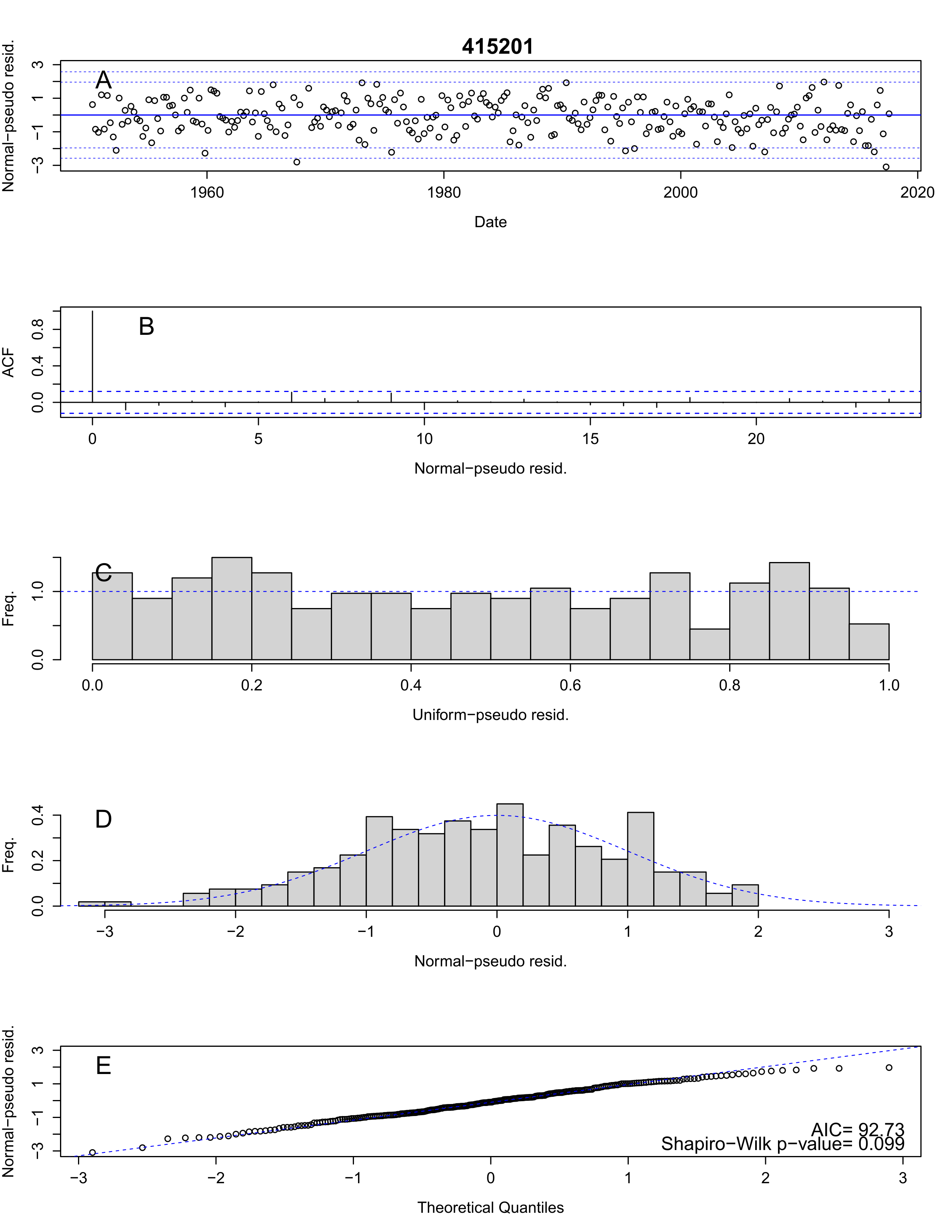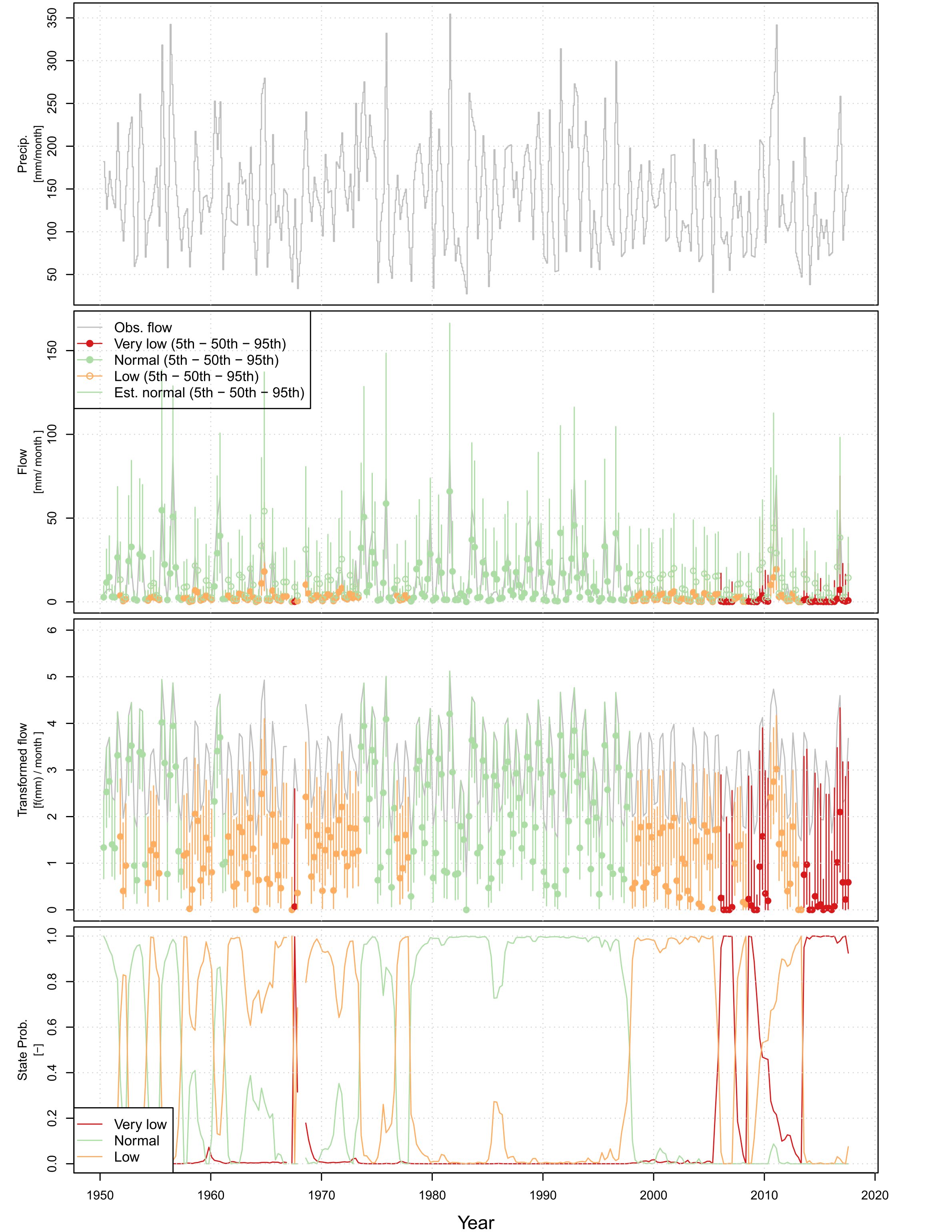Sub-annual models
Seasonal and monthly models provide further insight into the state of
the rainfall-runoff relationship throughout the year, but with this more
sensitive analysis, there is often more seasonal variation and
auto-correlation. hydroState provides additional options to explain this
variation so models are statistically adequate. These options are
located within the build() function. The seasonal variation
can be explained with a sinusoidal function for a particular parameter
through identifying seasonal.parameters in
build(). This vignette provides an example of an analysis
on a seasonal time-step with the intercept, a0, as a
seasonal.parameters.
Load required data
Seasonal and monthly rainfall-runoff models require a data frame with catchment average runoff and precipitation for each month. Load the data into the environment. Ensure there are four columns named “year”, “month”, “flow”, and “precipitation”, and verify the units for flow and precipitation are the same (‘mm’, ‘in’, etc.).
Note, hydroState parses the input.data given in
sequential order by year, month, and day (1950-01-01, 1950-01-02 or
1978-11, 1978-12, 1980-01, etc). Avoid re-labeling months in water-years
for seasonal and monthly input.data. Use calender
years.
data(streamflow_monthly_415201)
# check input data
head(streamflow_monthly_415201)
#> year month flow precipitation
#> 1 1950 1 0.000000 2.316268
#> 2 1950 2 0.000000 86.074245
#> 3 1950 3 2.044923 58.934578
#> 4 1950 4 1.189653 40.083532
#> 5 1950 5 1.098197 82.928550
#> 6 1950 6 2.417402 20.966111For a seasonal analysis, hydroState provides an additional
get.seasons() function to adjust the monthly data into
seasons. The flow and precipitation are summed every three months and
shown in the last month of the season. The number of months in each
season is included. An example of this is shown below.
# aggregate monthly data to seasonal
streamflow_seasonal_415201 = get.seasons(streamflow_monthly_415201)
# check seasonal data
head(streamflow_seasonal_415201)
#> year month flow precipitation nmonths
#> 1 1950 5 4.332774 181.9467 3
#> 2 1950 8 6.924973 126.3109 3
#> 3 1950 11 7.729439 170.7257 3
#> 4 1951 2 7.049185 141.9339 3
#> 5 1951 5 1.395975 128.1353 3
#> 6 1951 8 36.430009 227.4161 3Build a sub-annual hydroState model
For seasonal and monthly models, there are additional options when building a model. A default model can be built that is identical to the default annual model except on a monthly or seasonal time-step OR the model can be adjusted.
In addition to the options presented in adjusting the default state model
vignette, the seasonal and monthly models can assume parameters
within the rainfall-runoff relationship vary seasonally throughout the
year. This is available within the seasonal.parameters.
This assumes a parameter is best modeled as a sinusoidal
function representing seasonal trends. The input accepts any default
parameter: a1, a0, or std.
Typically, assuming seasonal trends in only the intercept,
a0, explains trends in the residuals of the model. For
further details, see build().
For this analysis, an adjusted model is built on a seasonal time-step:
Fit the model
Fit the built models with fit.hydroState(). This will
take typically an hour to run.
Review the residuals
Review the model’s residuals from figures using
plot.hydroState() to ensure they are uniform and normally
distributed with no trends or auto-correlation.
# review residual plots
plot(model.seasonal.fitted.415201, pse.residuals = TRUE, siteID = '415201') 
Evaluate the state-shifts
Set the state names relative to a year in the record using
setInitialYear(). This provides a name for the states so
they are easier to interpret in the following figures. Then plot the
state-shifts overtime using plot.hydroState(). In this
example, 1990 is chosen as the year of reference. All four plots within
the function are shown here, but either plot or combination of plots can
be selected. Alternatively, the states can be reviewed without plotting
using get.states() which returns a data frame of states at
each time-step.
# set the reference year to name the states
model.seasonal.fitted.415201 = setInitialYear(model.seasonal.fitted.415201, 1990)
# plot all four plots
plot(model.seasonal.fitted.415201)
Systematic model selection for sub-annual models
To identify the best sub-annual model, a systematic evaluation of the
possible model combinations can be performed using the
build.all() function. Below is an example evaluating all
possible model combinations when a0 and std
are the state dependent parameters, and a0 is expressed as
a seasonal.parameter. The procedure is identical to the
systematic model evaluation within the “Adjust the default state model
vignette”, expect seasonal.parameters may be selected.
Note, it is recommend to run this systematic analysis in parallel and on
a high-performance computer where possible. The example below can take
hours to fit 12 models when running in parallel on a 7-core, 64-bit
operating system.
# Build all possible models with the intercept, 'a0', as a seasonal parameter and state dependent parameter
all.models.seasonal = build.all(input.data = streamflow_seasonal_415201,
state.shift.parameter = c('a0','std'),
seasonal.parameter = 'a0')
# Review the order of the reference models, adjust reference models if needed.
all.models.ref.table = summary(all.models.seasonal)
# Re-build with adjusted reference table
all.models.seasonal = build.all(input.data = streamflow_seasonal_415201,
state.shift.parameter = c('a0','std'),
seasonal.parameter = 'a0',
summary.table = all.models.ref.table)
# Fit all models (takes hours to run)
<!-- all.models.seasonal = fit.hydroState(all.models.seasonal, pop.size.perParameter = 10, max.generations = 10000, doParallel = T) -->
# Identify the best model with the lowest AIC
get.AIC(all.models.seasonal.fitted.415201)
#> AIC nParameters AIC.weights
#> model.3State.gamma.boxcox.AR2.a0.seasonal.a0std 92.73299 23 9.999948e-01
#> model.3State.gamma.boxcox.AR3.a0.seasonal.a0std 117.07896 24 5.168178e-06
#> model.2State.gamma.boxcox.AR3.a0.seasonal.a0std 133.67572 15 1.286464e-09
#> model.3State.gamma.boxcox.AR1.a0.seasonal.a0std 150.25432 22 3.231464e-13
#> ...